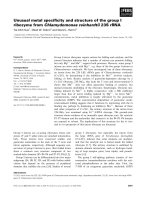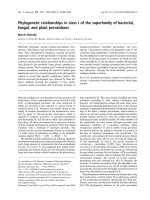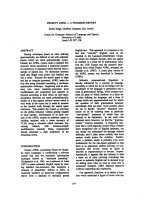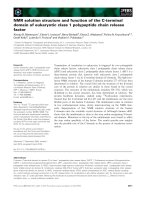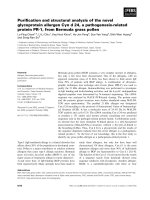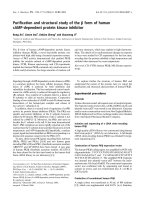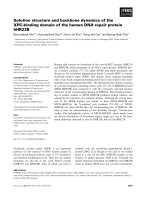Báo cáo khoa hoc:" Intestinal obstruction: a rare complication of channeling Transurethral Resection of the Prostate (TURP): a case report" doc
Bạn đang xem bản rút gọn của tài liệu. Xem và tải ngay bản đầy đủ của tài liệu tại đây (255.77 KB, 4 trang )
BioMed Central
Page 1 of 4
(page number not for citation purposes)
Journal of Medical Case Reports
Open Access
Case report
Intestinal obstruction: a rare complication of channeling
Transurethral Resection of the Prostate (TURP): a case report
AA Popoola*
1
, KA Onawola
1
, MD Adesina
2
and IO Olaoye
2
Address:
1
Urology Division, Department of Surgery, University of Ilorin Teaching Hospital, Ilorin, Nigeria and
2
General Surgery Division,
Department of Surgery, University of Ilorin Teaching Hospital, Ilorin, Nigeria
Email: AA Popoola* - ; KA Onawola - ; MD Adesina - ;
IO Olaoye -
* Corresponding author
Abstract
Introduction: Channeling transurethral resection of the prostate is a recognized form of
adjunctive treatment in the treatment of patients with prostate cancer. Despite the fact that
complications arising from the procedure have been on the decline, rare complications like
intestinal obstruction may occur.
Case presentation: This is a case report of a 56 year old man who developed mechanical
intestinal obstruction few days after a channeling TURP for advanced CaP.
Conclusion: The report highlights the possibility of intestinal obstruction as a secondary event
following a silent urinary bladder perforation during channeling TURP. Early recognition and
intervention were responsible for the good outcome in this patient.
Introduction
Transurethral resection of the prostate (TURP) represents
the accepted standard of surgical therapy for the manage-
ment of symptomatic bladder outlet obstruction due to
benign prostatic hyperplasia (BPH) [1]. Limited or Chan-
neling TURP is also a recognized form of adjunctive treat-
ment in the patients with Prostate cancer (CaP) [2-4]. The
procedure is used in such patients to relieve urinary reten-
tion, though about 50% of patients will pass urine per
urethram without catheters after varying lengths of time
after hormonal ablation therapy alone[5]. Channeling
TURP is associated with complications, which include uri-
nary bladder perforation [6,7]. However, the procedure
has become safer over the years in many institutions;
hence the complications rates from the procedure have
dropped significantly [8,9]. Intestinal obstruction is a very
rare complication of TURP as suggested by the scarcity of
reports in our search of the medical literatures. We there-
fore wish to use this case report to highlight the possibility
of intestinal obstruction as a secondary complication of
urinary bladder perforation.
Case presentation
A 56-year-old man presented to our unit 6 days after he
had a channeling TURP and bilateral orchidectomy per-
formed at another centre. He presented with generalized
colicky abdominal pain, abdominal distension and con-
stipation. Though the symptoms started on the first day
after the operation, they were not severe and he was dis-
charged from the hospital three days postoperatively.
There were associated vomiting, anorexia and hiccoughs,
which all started on the fifth day after surgery. The ure-
thral catheter was removed on the third postoperative day
and he experienced a significant improvement in his uri-
Published: 29 January 2008
Journal of Medical Case Reports 2008, 2:30 doi:10.1186/1752-1947-2-30
Received: 12 September 2007
Accepted: 29 January 2008
This article is available from: />© 2008 Popoola et al; licensee BioMed Central Ltd.
This is an Open Access article distributed under the terms of the Creative Commons Attribution License ( />),
which permits unrestricted use, distribution, and reproduction in any medium, provided the original work is properly cited.
Journal of Medical Case Reports 2008, 2:30 />Page 2 of 4
(page number not for citation purposes)
nary symptoms. He had no known history of hyperten-
sion or diabetes patient and there was no previous history
of intra-abdominal operations
Clinical examination at presentation revealed mild pallor,
fever (T-37.8°C), and bilateral peri-orbital and pedal
swellings. The pulses were normal but blood pressure was
170/100 mmHg. The abdomen was distended but soft
with no areas of tenderness. Percussion notes were tympa-
nitic and the bowel sounds were hyperactive. Digital rectal
examination revealed an enlarged nodular prostate and
the rectum contained soft brownish stool. The absent tes-
tes and the healing scrotal wound were noted. There was
no neuromuscular abnormality.
His hemoglobin was 11.2 g/dL; the white cell count was
10.8 × 10
9
/L, (neutrophilia of 73%) and platelet count of
258 × 10
9
/L. He had evidence of renal impairment: serum
urea was 28.2 mMol/L (normal range: 2.5–6.5 mMol/L)
and serum creatinine level was 744 μmol/L (53–106
μMol/l). He was hyponatraemic (Sodium 126 mMol/L)
(135–145 mMol/L) and slightly hyperkalaemic (Potas-
sium, 5.1 mMol/L) (2.9–5.0 mMol/L), Urinary specific
gravity was normal. Abdominal radiographs revealed fea-
tures of intestinal obstruction, with gaseous distension of
the bowel especially of the small bowel with multiple air
fluid levels and paucity of gas in the pelvis (see Figures 1
and 2). Abdomino-pelvic ultrasound scanning revealed
bilateral moderate hydronephrosis, a thickened urinary
bladder wall with irregularity in its lower segment and
remnants of the prostate gland. Urine microbiology cul-
ture yielded growth of klebsiella pneumoniae, which was
sensitive to ceftazidime and amoxicillin-clavulanic acid
combination.
It was apparent that the patient had intestinal obstruction
occurring after the Channel TURP with obstructive neph-
ropathy. Initially, conservative management was insti-
tuted vis a vis nothing by mouth, intravenous fluids
(normal saline alternating with 5% dextrose-saline), and
intravenous antibiotics using a combination of ceftazi-
dime and metronidazole. The gastro-intestinal tract was
decompressed by passing a naso-gastric tube for continu-
ous drainage. A size 18 Fr Foley urethral catheter was
passed to monitor the patient's urine output and to
decompress the upper urinary tract.
The patient's renal function improved significantly with
the conservative management but the abdominal pain
and distension persisted and got worse. On the tenth day
of admission, he had an exploratory laparotomy. Findings
at laparotomy were distended small bowel loops and
multiple adhesions involving the dome of the bladder,
the small intestine and the large omentum. Adhesiolysis
was done and the intestinal loops were released. The post-
operative period was uneventful and he was commenced
on graded oral diet on the third postoperative day after
which he moved his bowel on the same day. The renal sta-
tus of the patient continued to improve and urethral cath-
eter was removed on the tenth postoperative day, and the
patient voided satisfactorily. The serum electrolyte and
urea levels at discharge were all within normal ranges
(Sodium, 135 mMol/L; Potassium, 4.4 mMol/L; Urea-4.8
mMol/L and creatinine – 88 μMol/L). The patient was dis-
charged from the hospital on antihypertensive medica-
tions 22 days after admission. He was seen in the out
patient department six months after discharge and his
condition had remained satisfactory.
Discussion
Trans urethral resection of the prostate (TURP) has been
recognized as an adjuvant therapy in the management of
advanced prostate cancer. This is mainly to create a chan-
nel in the obstructive tumour thereby relieving the urinary
retention. This may be carried out on the patient parri
passu with the hormonal ablation therapy to relieve uri-
nary retention. Hormonal ablation alone usually results
in the relief of urinary retention in about 50% of patients
after varying periods of urethral catheterization. This can-
not always be guaranteed. Channeling TURP can be
preemptive when it is carried out about the time when the
Supine shows distended bowel loopsFigure 1
Supine shows distended bowel loops.
Journal of Medical Case Reports 2008, 2:30 />Page 3 of 4
(page number not for citation purposes)
hormonal ablation is initiated as in the case presented. It
may also be indicated when the patient's urinary retention
is not relieved after a reasonable period after initiating
hormonal ablation. Urinary bladder perforation is one of
the complications of the procedure [10] and it occurs in
less than 1% of cases in some series [8,11]. Most cases of
bladder perforation from TURP are managed conserva-
tively by continuous drainage of the urinary bladder,
when recognized early. However, some cases of perfora-
tion may be missed with no repercussions especially when
there are other reasons to keep the urethral catheters on
for several days after TURP [11]. Reports of secondary
complications resulting from perforation of the urinary
bladder have been reported. These are extravesical tumor
recurrence [12] intraperitoneal extravasation of irrigating
fluid[13] and transurethral resection (TUR) syn-
drome[14]. The patient in this report sustained an intra-
peritoneal perforation of the urinary bladder, which was
not recognized immediately after the TURP. The greater
omentun, in a bid to seal off the perforation on the dome
of the bladder, entangled the intestine with the resultant
intestinal obstruction. Early recognition and intervention
in the management of this complication was responsible
for the good outcome in the management of this patient
with impaired renal function from the chronic bladder
outlet obstruction.
Conclusion
TURP will remain an important adjunct in the manage-
ment of patients with advanced CaP. Although, the TURP
over the years has become a safe procedure in most expe-
rienced hands, possibility of complications occurring
should always be borne in mind. Early recognition and
management of such complications usually result in good
outcome.
Abbreviations
TURP – Transurethral resection of the prostate; CaP –
Cancer of the prostate; Fr – French gauge; mMol/L – Mil-
limole/Litre; μMol/L – Micromole/Litre.
Competing interests
The author(s) declare that they have no competing inter-
ests.
Authors' contributions
AAP initiated the concept, literature search and write up of
the manuscript. KAO involved in case summary. MDA
contributed in clinical management of patient and gave
approval for final write up. IOO contributed in clinical
management of patient and gave approval for final write
up. All authors read and approved the final manuscript.
Consent
Written informed consent was obtained from the patient
for publication of this case report and any accompanying
images. A copy of the written consent is available for
review by the Editor-in-Chief of this journal.
Acknowledgements
The authors appreciates the participations of the Doctors in the two sur-
gical units who participated in the management of this patient, thereby mak-
ing it possible to report on him.
References
1. Cattolica EV, Sidney S, Sadler MC: The safety of transurethral
prostatectomy: a cohort study of mortality in 9416 men. J
urol 1997, 158:102-4.
2. Sehgal A, Mandhani A, Gupta N, Dubey D, Srivastava A, Kapoor R,
Kumar A: Can the Need for Palliative Transurethral Prostatic
Resection in Patients with Advanced Carcinoma of the Pros-
tate Be Predicted? J Endourol 2005, 19(5):546-9.
3. Gnanapragasam VJ, Kumar V, Langton D, Pickard RS, Leung HY: Out-
come of transurethral prostatectomy for the palliative man-
agement of lower urinary tract symptoms in men with
prostate cancer. International Journal of Urology 2006, 13(6):711-5.
4. Flam TA, Peyromaure M, Chauveinc L, Thiounn N, Firmin F, Cosset
JM, Bernard D: Post-brachytherapy transurethral resection of
the prostate in patients with localized prostate cancer. J Urol
2004, 172(1):108-11.
5. Varenhorst E, Alund G: Urethral obstruction secondary to car-
cinoma of prostate: response to endocrine treatment. Urol-
ogy 1985, 25:354-356.
6. Barbieri A, Simonazzi M, Marcato C, Larini P, Barbagallo M, Frattini A,
Cortellini P: Massive Hematuria after Transurethral Resection
of the Prostate: Management by Intra-Arterial Emboliza-
tion. Urol Int 2002, 69:318-20.
7. Suzuki Y, Nakada T, Ishigooka M, Hashimoto T, Abe Y, Sasagawa I,
Kubota Y: Pelvic Arteriovenous Aneurysm Caused by
Erect film shows multiple air-fluid levelsFigure 2
Erect film shows multiple air-fluid levels.
Publish with BioMed Central and every
scientist can read your work free of charge
"BioMed Central will be the most significant development for
disseminating the results of biomedical research in our lifetime."
Sir Paul Nurse, Cancer Research UK
Your research papers will be:
available free of charge to the entire biomedical community
peer reviewed and published immediately upon acceptance
cited in PubMed and archived on PubMed Central
yours — you keep the copyright
Submit your manuscript here:
/>BioMedcentral
Journal of Medical Case Reports 2008, 2:30 />Page 4 of 4
(page number not for citation purposes)
Transurethral Resection of the Prostate: Successful Manage-
ment by Intra-Arterial Embolization. Urol Int 1998, 60:191-193.
8. Lim KB, Wong MYC, Foo KT: Transurethral resection of pros-
tate (TURP) through the decades – a comparison of results
over the thirty years in a single institution in Asia. Ann Acad
Med Singapore 2004, 33:775-9.
9. Ignatoff JM, O'Conor J: Complications of transurethral resec-
tion of prostate. Int J urol and neph 1997, 9(1):33-40.
10. Uchida T, Adachi K, Ao T, Fujino A, Omata T, Yoshizawa K,
Kurokawa J, Kadowaki K, Shoji K, Yokoyama E: Pre-operative,
operative and postoperative complications in 2266 cases of
transurethral resection of the prostate. Nippon Hinyokika
Gakkai Zasshi 1993, 84(5):897-905.
11. Martov AG, Kornienko SI, Gushchin BL, Ergakov DV, Sazonov OA:
Intraoperative urological complications in transurethral sur-
gical interventions on the prostate for benign hyperplasia.
Urologiia 2005:3-8.
12. Skolarikos A, Chrisofos M, Ferakis N, Papatsoris A, Dellis A, Delive-
liotis C: Does the management of bladder perforation during
transurethral resection of superficial bladder tumors predis-
pose to extravesical tumor recurrence? J Urol 2005,
173(6):1908-11.
13. Weber S, Acuff JH, Mazloomdoost M, Kirimli BI: Transurethral
prostatectomy complicated by intraperitoneal extravasa-
tion of irrigating fluid. Can J Anest 1987, 34:193-5.
14. Dorotta I, Basali A, Ritchey M, O'Hara JF, Sprung J: Transurethral
resection syndrome after bladder perforation. Anesth Analg
2003, 97:1536-8.


